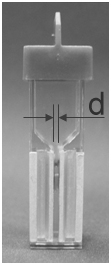Standard
Electropoaration Cuvette
gap distance:
d = 1, 2, or 4 mm
 |
|
Calculation of Required Pulse Voltage:
Energy Delivered Per Pulse:
The calculation uses the input for electric field and gap distance above!
Charge Transfered Per Pulse:
The calculation uses the input for electric field, gap distance, and conductivity above!
Temperature Increase of Suspension Per Pulse (adiabatic):
The calculation uses the input for electric field, gap distance, and conductivity above!
|
|
Notes:
Calculation of the electric field for a given voltage and cuvette gap distance:
The pulse generators at the Frank Reidy Research Centers are usually hooked up to an oscilloscope with Tektronix voltage probe P6015A. Since we
usually have not set a calibration value on the oscilloscope the 'real' voltage applied to the cuvette measured in kilovolts (kV) is observed
on the oscilloscope in volts (V). This means, if you have/need for example a voltage of 10 kV applied to the cuvette, the pulse amplitud observed
on the oscilloscope is 10 V. The calculations here are only valid for the simple geometry of a cuvette filled with a liquid. More complex
geometries, samples and experiments, such as used for example in in vitro experiments can not be analyzed with the calculators here. The calculation of the temperature increase assumes a specific heat capacity of 4.2 kJ·kg-1·K-1,
it is assumed that it is basically water that is heated. The heated volume is calculated automatically from the gap-distance and the known electrode area, which is
the same for any electroporation cuvette independent from the manufacturer. The transfered charge per pulse (used as scaling parameter for the charging of cell membranes "E·τ") is given in units of "µAs," i.e. "micro-amps-seconds," or equivalent "micro-coulombs." Conversion from resistivities to conductivities:
For all practical purposes, can the conductivity of a cell-suspension be substituted by the conductivity of the buffer.
If any of the computations for energy, energy density, charge, or temperature change results in zero, then the calculated value is so small that it is negligible.
(Smaller than two digits after the decimal point for the given unit.)
|
|